Mediator subunit MED25 links the jasmonate receptor to transcriptionally active chromatin
- PMID: 28973940
- PMCID: PMC5651773
- DOI: 10.1073/pnas.1710885114
Mediator subunit MED25 links the jasmonate receptor to transcriptionally active chromatin
Abstract
Jasmonoyl-isoleucine (JA-Ile), the active form of the plant hormone jasmonate (JA), is sensed by the F-box protein CORONATINE INSENSITIVE 1 (COI1), a component of a functional Skp-Cullin-F-box E3 ubiquitin ligase complex. Sensing of JA-Ile by COI1 rapidly triggers genome-wide transcriptional changes that are largely regulated by the basic helix-loop-helix transcription factor MYC2. However, it remains unclear how the JA-Ile receptor protein COI1 relays hormone-specific regulatory signals to the RNA polymerase II general transcriptional machinery. Here, we report that the plant transcriptional coactivator complex Mediator directly links COI1 to the promoters of MYC2 target genes. MED25, a subunit of the Mediator complex, brings COI1 to MYC2 target promoters and facilitates COI1-dependent degradation of jasmonate-ZIM domain (JAZ) transcriptional repressors. MED25 and COI1 influence each other's enrichment on MYC2 target promoters. Furthermore, MED25 physically and functionally interacts with HISTONE ACETYLTRANSFERASE1 (HAC1), which plays an important role in JA signaling by selectively regulating histone (H) 3 lysine (K) 9 (H3K9) acetylation of MYC2 target promoters. Moreover, the enrichment and function of HAC1 on MYC2 target promoters depend on COI1 and MED25. Therefore, the MED25 interface of Mediator links COI1 with HAC1-dependent H3K9 acetylation to activate MYC2-regulated transcription of JA-responsive genes. This study exemplifies how a single Mediator subunit integrates the actions of both genetic and epigenetic regulators into a concerted transcriptional program.
Keywords: COI1; MED25; MYC2; jasmonate; nuclear hormone receptor.
Conflict of interest statement
The authors declare no conflict of interest.
Figures



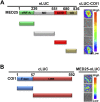
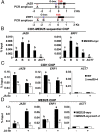


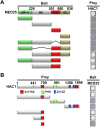


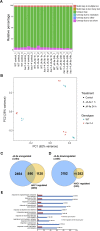

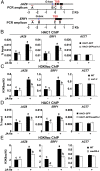



Similar articles
-
Conserved function of mediator in regulating nuclear hormone receptor activation between plants and animals.Plant Signal Behav. 2018;13(5):e1403709. doi: 10.1080/15592324.2017.1403709. Epub 2018 Jun 22. Plant Signal Behav. 2018. PMID: 29125388 Free PMC article.
-
LEUNIG_HOMOLOG Mediates MYC2-Dependent Transcriptional Activation in Cooperation with the Coactivators HAC1 and MED25.Plant Cell. 2019 Sep;31(9):2187-2205. doi: 10.1105/tpc.19.00115. Epub 2019 Jul 18. Plant Cell. 2019. PMID: 31320481 Free PMC article.
-
MED25 connects enhancer-promoter looping and MYC2-dependent activation of jasmonate signalling.Nat Plants. 2019 Jun;5(6):616-625. doi: 10.1038/s41477-019-0441-9. Epub 2019 Jun 10. Nat Plants. 2019. PMID: 31182849
-
Mediator subunit MED25: at the nexus of jasmonate signaling.Curr Opin Plant Biol. 2020 Oct;57:78-86. doi: 10.1016/j.pbi.2020.06.006. Epub 2020 Aug 7. Curr Opin Plant Biol. 2020. PMID: 32777679 Review.
-
JAZ repressors set the rhythm in jasmonate signaling.Curr Opin Plant Biol. 2008 Oct;11(5):486-94. doi: 10.1016/j.pbi.2008.06.003. Epub 2008 Jul 22. Curr Opin Plant Biol. 2008. PMID: 18653378 Review.
Cited by
-
A class of independently evolved transcriptional repressors in plant RNA viruses facilitates viral infection and vector feeding.Proc Natl Acad Sci U S A. 2021 Mar 16;118(11):e2016673118. doi: 10.1073/pnas.2016673118. Proc Natl Acad Sci U S A. 2021. PMID: 33836579 Free PMC article.
-
The N-terminal α2 helix element is critical for the activity of the rice transcription factor MYC2.Plant Mol Biol. 2024 Jan 8;114(1):2. doi: 10.1007/s11103-023-01411-y. Plant Mol Biol. 2024. PMID: 38189841
-
The Multifaceted Roles of MYC2 in Plants: Toward Transcriptional Reprogramming and Stress Tolerance by Jasmonate Signaling.Front Plant Sci. 2022 Apr 25;13:868874. doi: 10.3389/fpls.2022.868874. eCollection 2022. Front Plant Sci. 2022. PMID: 35548315 Free PMC article. Review.
-
Jasmonates modulate sphingolipid metabolism and accelerate cell death in the ceramide kinase mutant acd5.Plant Physiol. 2021 Nov 3;187(3):1713-1727. doi: 10.1093/plphys/kiab362. Plant Physiol. 2021. PMID: 34618068 Free PMC article.
-
Ethylene increases the NaHCO3 stress tolerance of grapevines partially via the VvERF1B-VvMYC2-VvPMA10 pathway.Plant Biotechnol J. 2025 Apr;23(4):1076-1090. doi: 10.1111/pbi.14565. Epub 2025 Jan 7. Plant Biotechnol J. 2025. PMID: 39777954 Free PMC article.
References
-
- Browse J. Jasmonate passes muster: A receptor and targets for the defense hormone. Annu Rev Plant Biol. 2009;60:183–205. - PubMed
-
- Xie DX, Feys BF, James S, Nieto-Rostro M, Turner JG. COI1: An Arabidopsis gene required for jasmonate-regulated defense and fertility. Science. 1998;280:1091–1094. - PubMed
-
- Thines B, et al. JAZ repressor proteins are targets of the SCF(COI1) complex during jasmonate signalling. Nature. 2007;448:661–665. - PubMed
-
- Chini A, et al. The JAZ family of repressors is the missing link in jasmonate signalling. Nature. 2007;448:666–671. - PubMed
Publication types
MeSH terms
Substances
LinkOut - more resources
Full Text Sources
Other Literature Sources

